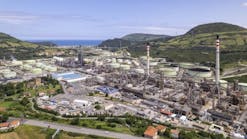While researching health and safety information on the American Petroleum Institute's web site, this editor found an annual survey of nonfatal injuries and illnesses in the workplace. According to API's Workplace Safety Report, the number of oil and natural gas industry jobrelated nonfatal injuries and illnesses has decreased. In 1998 the number of nonfatal injuries and illnesses was 4.4 per 100 fulltime workers. In 2007, that statistic decreased to 3 per 100 fulltime workers.
This report compares the rates of job-related nonfatal injuries and illnesses within the US oil and gas industry with comparable US industries. The oil and gas industry's safety record has consistently improved, reflecting its commitment to health and safety.
Personal protective equipment
As part of the commitment to improving the safety of the industry, Red Wing Shoe Co. announced in May the expansion of its existing line of workwear garments to include a complete offering of personal protective equipment for the global oil and gas industry. Red Wing has designed a full line of work boots specifically for oil and gas workers.
The leather is oil-tanned, which presaturates it and prevents it from absorbing contaminants encountered at drillings sites. It also makes it long-lasting. The leathers also resist many caustic materials, which can cause work boots to break down prematurely.
Red Wing soles are also rated for resistance to oil and gas based upon the "oil swell" test. This test measures the percentage of how much a sole swells when submerged in oil (the less swell the better). This ensures that the sole isn't absorbing too much oil and gas, resulting in excessive wear.
Training, safety programs
Meanwhile, Petrofac Training became the first training provider to be approved by The Oil and Gas Academy to deliver the new Minimum Industry Safety Training, or MIST, course. The MIST course has been designed to introduce the fundamental safety elements of the offshore oil and gas industry to new starts. The course was developed in line with Step Change in Safety's goal to make the UK the safest oil and gas E&P province in the world by 2010.
The course features nine modules, which include understanding the risk assessment process, tasks that require permit to work, controlling the use of hazardous substances offshore, knowledge and practices of working at height, and awareness of mechanical lifting activities.
Many oil and gas companies have safety programs. ExxonMobil Corp.'s safety program is called "Nobody gets hurt." ExxonMobil leads the industry with low incident rates for work-related injuries and illnesses. Since 2000, ExxonMobil has reduced workforce lost-time incident rate by an average of over 12%/year.
Employees and contractors receive rigorous training before commencing work in ExxonMobil's facilities. They participate in safety teams, conduct safety observations, and suggest ongoing improvements in safety procedures. In 2008, more than 1,600 of the company's contractor supervisors and managers participated in leadership workshops conducted by ExxonMobil Development Co., an increase of more than 20% since 2007.
ExxonMobil is working toward a goal of zero safety and health incidents. By using specially tailored tools and techniques, including ergonomics, the number of accidents and cases of illness at work can be reduced. Many ExxonMobil organizations have reduced injuries through behavior-based safety tools incorporated in their personnel safety management systems.
Human factors, such as fatigue, influence people's performance and behavior. According to ExxonMobil, the most effective way to incorporate human factors into equipment and systems set-up is at the initial facility design and development stage. By involving operating personnel and considering the principles of human factors early in a project's development, it reduces costly rework and performs smoother startups with lower incident frequency.
Compliance
In June, the US Occupational Safety and Health Administration sent letters to refinery managers emphasizing the need to comply with all applicable OSHA standards, particularly the Process Safety Management of Highly Hazardous Chemicals.
OSHA sent letters to the management of more than 100 refineries. The letters outlined compliance issues found under OSHA's Refinery National Emphasis Program and urged refiners to comply with their obligations under the process safety management standard. The standard requires employers to develop and incorporate comprehensive, sitespecific safety management systems to reduce the risks of fatal or catastrophic incidents.
"We initiated this NEP to ensure that refineries develop and fully implement a safety management system that protects workers from serious incidents," said acting Assistant Secretary of Labor for OSHA Jordan Barab.


